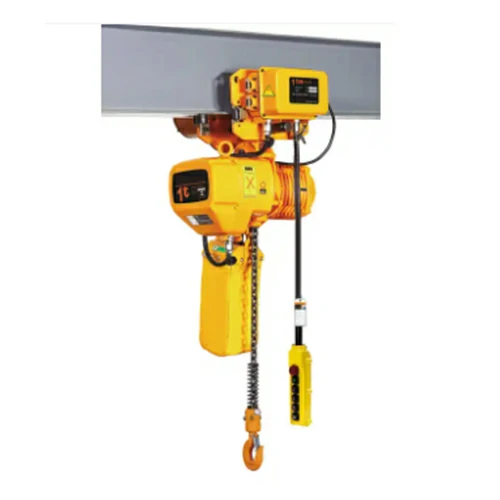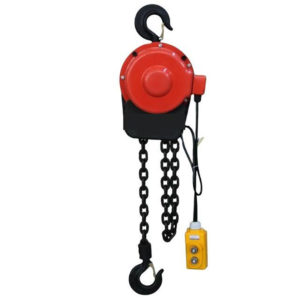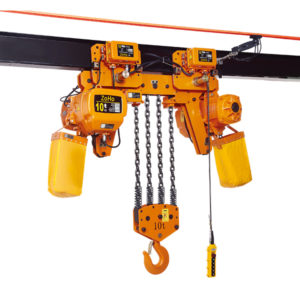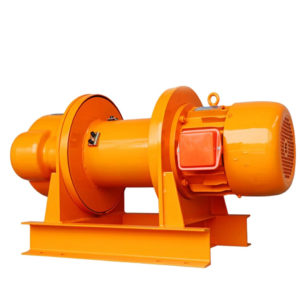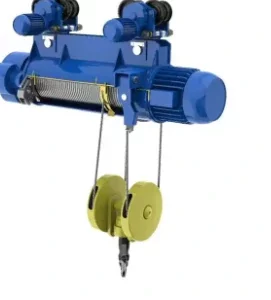High Quality 5 Ton Electric Chain Hoist Block
Chain block, as a simple and practical mechanical tool, is widely used in various fields, providing an effective solution for people to lift and carry heavy objects.
The design of this tool is inspired by ancient mechanical principles, but it still plays an important role in modern society.
This article will discuss in detail the structure, working principle, application fields, advantages and disadvantages of chain block from different angles.
Product Description
A chain block usually consists of a few main parts: a body, a handle, a chain or rope, and a gear system. The main body is the supporting structure of the chain block, usually made of a strong metal material to withstand the load of the heavy object. The handle is located on one side of the main body for the operator to turn to convert manpower into mechanical kinetic energy. Chains or ropes are attached to the weight and passed around a gear system for lifting and lowering. The gear system is the core part of the chain block. It consists of a series of gears. They are connected to the handle through the shaft. When the handle is rotated, the gears will also rotate to drive the chain or rope up and down.
The working principle of the chain block is based on the principle of the roller. By continuously pulling the handle, the operator inputs manpower into the gear system inside the hoist. The gear system is designed so that each rotation causes the chain or rope to pass around one gear, raising or lowering the attached weight. This mechanical advantage allows users to perform tasks such as lifting or lowering heavy objects with relatively little effort.
chain block have a wide range of applications in many fields. In industry, they are often used to move heavy machinery parts, load and unload goods, and adjust the height of equipment. On construction sites, chain block can be used to lift building materials such as steel beams and concrete blocks. In the field of warehouse and logistics, chain block are used for loading and unloading operations of goods, which improves work efficiency. In addition, they are useful in various scenes such as stage construction and car maintenance.
However, chain block also have some limitations. First, their use is limited by the physical strength of the operator, who cannot handle overly heavy objects. Secondly, although the mechanical advantage reduces the difficulty of operation, it still requires a certain amount of physical effort in the process of continuously pulling the handle. In addition, chain block are relatively slow to raise and lower and may not be suitable for tasks that require rapid operation.
To sum up, as an ancient and practical mechanical tool, the chain block still plays an important role in modern society. Its simple structure and working principle enable people to complete the tasks of lifting and lowering heavy objects by manpower, thereby improving work efficiency in various fields. However, its load and speed limitations need to be considered when using it to select the right tool to meet the task requirements.

The main components of the Chain block include:
As a mechanical tool, the chain block has a complex internal structure and exquisite design so that it can effectively complete the lifting and handling tasks of heavy objects. It is composed of several main components, each of which plays a key role in the overall working. The main components and functions of the chain block will be introduced in detail below.
Main structure: The main body of a chain block is its overall supporting structure, usually made of strong metal material to ensure sufficient strength and durability. The main body integrates other components together through various connecting parts. Its robust housing protects the internal mechanical components from the outside environment.
Handle: The handle is the part that the operator holds in his hand and turns. Through the rotation of the handle, the human power is transmitted to the gear system of the hoist, thereby realizing the lifting and lowering of heavy objects. Handles are usually designed in an ergonomic shape to provide a better grip and operating experience.
Gear system: The gear system is the core part of the chain block. It is responsible for converting the operator’s manpower into mechanical kinetic energy and controlling the lifting of heavy objects. A gear system usually consists of multiple gears that are connected together by shafts to form a complex mechanical transmission system. When the handle is rotated, the transmission relationship between the gears makes the chain or rope go around the gears to realize the movement of the weight.
Chain or Rope: The chain or rope is what connects the chain block to the weight, and they move through the rollers or pulleys in the gear system to transfer the force to the weight. The chain or rope needs to be strong and wear-resistant enough to carry the load of the heavy object. In some special cases, it is also possible to use stronger materials such as steel wire rope.
Pulleys or Rollers: Pulleys, or rollers, are a key part of a gear system that allow a chain or rope to move between gears, raising or lowering heavy objects. Pulleys typically have a smooth surface to reduce wear on the chain or rope while allowing smooth movement.
Connectors and Fixtures: The various parts of the chain block need to be firmly connected together by connectors and fixtures. These connectors can be screws, nuts, pins etc., which ensure that the various components will not loosen or fall off during the work.
Brakes: Some chain block may be equipped with brakes to control the speed at which the weight is lowered or to stop it. Braking devices can be friction brakes, locking brakes, etc., which help provide more precise control and safety.
Guards and Hand Guards: For operator safety, some chain block may be equipped with guards or hand guards to prevent accidental pinching of the operator by the handle or gear system.
To sum up, the main components of the chain block work together to convert the operator’s manpower into mechanical kinetic energy, thereby realizing the lifting and lowering of heavy objects. Its compact design and solid structure make it play an important role in various fields, improving work efficiency and reducing the burden on manpower. However, when using chain block, the operator should pay attention to safe operation to ensure the safety and reliability of the working process.
Why choose us
When choosing a chain block supplier, several factors are involved, including product quality, performance, service, price, etc. Here are some reasons that may influence your choice, which may apply to any company, depending on your needs and the characteristics of your company.
Product Quality and Reliability: When selecting a chain block, the primary consideration is product quality and reliability. The chain block you want to buy should have a solid structure, durable materials, and reliable performance to ensure long-term use without failure.
Performance and applicability: Different work scenarios and tasks may require chain blockwith different performances. It’s important to choose a model that works for your specific needs. Make sure the selected product meets your lifting and handling requirements.
Safety: The safety of the chain block during use is very important. When selecting a supplier, ensure that their products comply with relevant safety standards and may offer additional safety features such as guards, hand guards, etc. to reduce operational risk.
Service and Support: Equally important is the provider’s level of service and support. Do they provide pre-sales consultation, after-sales service, maintenance support, etc.? Can I get timely technical support and help to solve problems after purchase?
Price and value for money: Price is also a key factor in the decision. You need to make sure that the chain block you choose is within a reasonable price range and offers good value for money, a balance of quality and performance against price.
User Testimonials and Word of Mouth: Finding out what other customers have said about a supplier can help you better understand the quality of their products and services. You can get this information through online reviews, social media, etc.
Customization ability: If you have special needs, such as customized size or function, it may be more appropriate to choose a supplier with customization ability.
Environmental factors: It is also becoming more and more important to consider the environmental factors of products. If you care about sustainability and the environment, you can find out whether your suppliers’ product manufacturing and material selection meet relevant standards.
In conclusion, choosing a chain block supplier requires comprehensive consideration of multiple factors to ensure that your choice can meet your needs and provide high-quality products and services. Before making a decision, it’s best to do detailed research and comparisons to ensure you’re making an informed choice.
Advantage:
As a mechanical tool, the Chain block offers several advantages in various lifting and carrying tasks. Here are some common chain block advantages:
Simple and easy to use: The operation of the chain block is relatively simple, and the lifting and lowering of heavy objects can be realized only by pulling the handle. Operators can quickly get started without complicated training or expertise.
Portability: Due to the relatively light structure of the chain block, its portability is high. People can easily carry and move the Chain block to different job sites.
Flexibility: The chain block is suitable for a variety of different work scenarios, whether it is in industry, construction, storage or other fields, it can play a role.
Manpower saving: chain block can effectively convert the operator’s manpower into lifting force through mechanical advantages, thus saving a lot of manpower when lifting heavy objects.
Affordable: Compared to other, more complex lifting equipment, chain block typically have a low purchase cost, making them an economical choice.
Precise control: Although manual operation, the user can relatively precisely control the lifting speed and position of the heavy object, suitable for tasks that require fine manipulation.
Reliability: Due to the relatively simple design of the chain block, its mechanical parts often have high reliability and durability, and can work stably for a long time.
Adapt to a variety of loads: chain block can handle loads of different weight levels. By choosing chain block different models or specifications, different lifting needs can be met.
No need of electricity: chain block do not need external power supply, completely rely on human operation, suitable for places without electricity supply.
Safety: Some chain block are equipped with safety devices, such as brakes, which can provide greater safety during operation and prevent heavy objects from falling suddenly.
While chain block have many advantages, there are some limitations to be aware of, such as possible limitations when handling excessively heavy loads or when quick maneuvers are required. Choosing the right lifting equipment requires comprehensive consideration of the characteristics and needs of the task.
FAQ:
Q1. I want more styles, how to get the latest directory for your reference?
Answer: You can contact us through emails. We will provide you with the latest directory based on your information.
Q2. Can you add our own logo on the product?
Yes. We provide services to add customer logo. There are many types of this service. If you have this need.
Q3. What do your factory do in quality control?
Answer: “Quality is priority? We always attach great importance to quality control 1) Skilled workers are concerned about all details of the process of processing and packaging. 2) The quality control department is particularly responsible for the quality inspection in each process
Q4. What is the order?
you can tell us the model of the product you like, we will send you a quotation to you.
